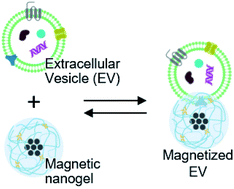Reversible conjugation of biomembrane vesicles with magnetic nanoparticles using a self-assembled nanogel interface: single particle analysis using imaging flow cytometry†
Abstract
Nanoscale biomembrane vesicles such as liposomes and extracellular vesicles are promising materials for therapeutic delivery applications. However, modification processes that disrupt the biomembrane affect the performance of these systems. Non-covalent functionalization approaches that are facile and easily reversed by environmental triggers are therefore being widely investigated. In this study, liposomes were successfully hybridized with magnetic iron oxide particles using a cholesterol-modified pullulan nanogel interface. Both the magnetic nanoparticles and the hydrophobic core of the lipid bilayer interacted with the hydrophobic cholesteryl moieties, resulting in stable hybrids after simple mixing. Single particle analysis by imaging flow cytometry showed that the hybrid particles interacted in solution. Calcein loaded liposomes were not disrupted by the hybridization, showing that conjugation did not affect membrane stability. The hybrids could be magnetically separated and showed significantly enhanced uptake by HeLa cells when a magnetic field was applied. Differential scanning calorimetry revealed that the hybridization mechanism involved hydrophobic cholesteryl inserting into the biomembrane. Furthermore, exposure of the hybrids to fetal bovine serum proteins reversed the hybridization in a concentration dependent manner, indicating that the interaction was both reversible and controllable. This is the first example of reversible inorganic material conjugation with a biomembrane that has been confirmed by single particle analysis. Both the magnetic nanogel/liposome hybrids and the imaging flow cytometry analysis method have the potential to significantly contribute to therapeutic delivery and nanomaterial development.



 Please wait while we load your content...
Please wait while we load your content...